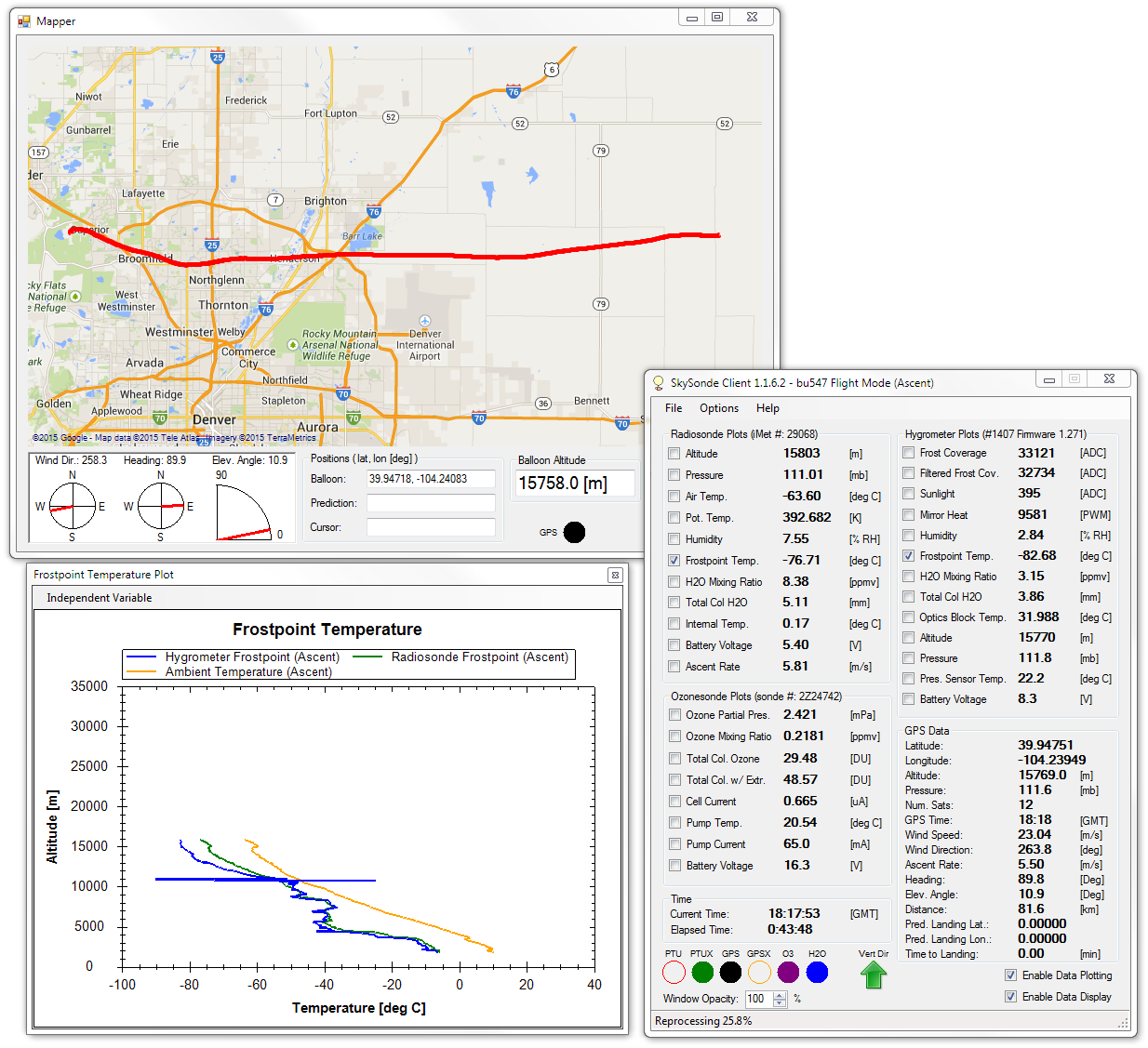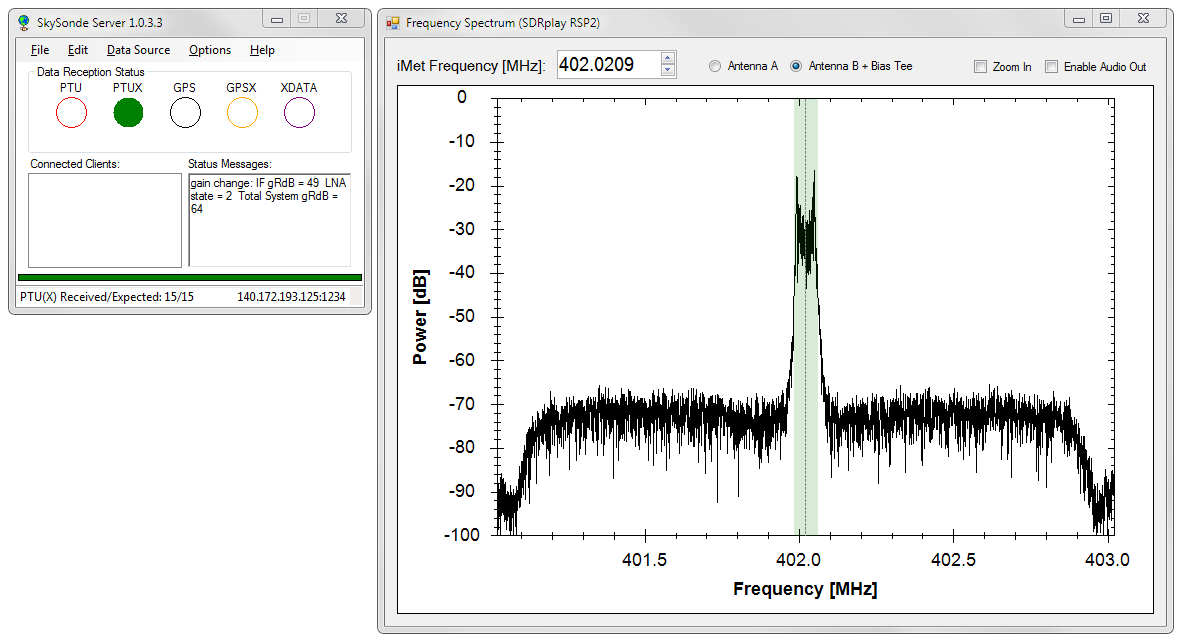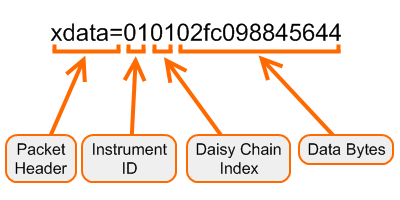GML Water Vapor
NOAA GML/OZWV Software Downloads
These software packages were developed by the NOAA Ozone and Water Vapor Group to assist with weather balloon launch planning, data collection/processing, and instrument setup. They are written for Windows (XP/Vista/7/8/10/11) and require the .NET Framework 4.0 or higher (typically already installed on modern computers). Contact Information:
| Current Software Developer: | Alex Fritz | Primary - alex.fritz@colorado.edu | Secondary - alex.fritz@noaa.gov |
| Design/QA/Testing: | Emrys Hall | Primary - emrys.hall@noaa.gov | Secondary - emrys.hall@colorado.edu |
| Supervisor/PI: | Elizabeth Asher | Primary - elizabeth.asher@colorado.edu | Secondary - elizabeth.asher@noaa.gov |
| Original Software Developer: | Allen Jordan |
Disclaimer: The availability of these tools to the general public does not condone attempts to recover balloon payloads that land on private property, government property, or hazardous locations. Predicted trajectories and landing zones are only approximate, therefore active tracking is required to accurately locate launched payloads.
Balloon Prediction
This program forecasts weather balloon trajectories and landing locations, showing the resulting path on a map. Use this to help select safe launch days, avoiding airports, city centers, and other hazardous landing zones (though accurate results are not guaranteed).

Balloon Prediction Version 0.9.8.7, 2025/09/23
- Calculates weather balloon trajectories/paths and landing locations
- Uses NOAA GFS model wind data, or NWS radiosonde soundings as input
- Custom burst/turn altitude, launch locations, dates/times, and time zones
- Adjustable rise rate tables for different balloons/payloads
- Detailed mapping, selectable map sources
- Google Earth KML output file for 3D trajectory viewing
SkySonde Client/Server
A pair of programs for collecting and displaying Intermet iMet-1, iMet-4, and iMet-54 radiosonde data telemetry in real-time during a weather balloon flight, along with the NOAA Frostpoint Hygrometer (FPH), EN-SCI/DMT ECC Ozonesonde, and several other instruments.
NOTE: This program will NOT receive National Weather Service radiosonde data, as they use different radiosonde models/formats.

Client: 1.4.6.13, 2025/07/10 Server: 1.0.6.2, 2021/11/23
- Parses, displays, and stores wireless data from iMet radiosondes
- Support for the NOAA FPH and ECC Ozonesonde is built in
- Extra instrument plugins included for the ETH COBALD, Anasphere SLWC, MetOne OPC, NOAA POPS, and EN-SCI CFH (contact Alex Fritz to add more)
- Client/Server architecture. Can be run on the same computer or across a network (a server computer attached to the receiver, one or more client computers displaying and saving the data)
- Audio input data from a receiver can be demodulated directly without a physical modem
- NEW: Software-defined radio (SDR) receiver support for the RTL-SDR and all SDRplay models. This allows for high-quality affordable receiving systems to be setup with a minimum amount of equipment (see below). The digital filters used with SDR input were designed with genetic algorithms to be optimal for Intermet radiosondes.
- Important: If using the SDRplay, download and install the latest "API/HW Driver – v3.09 or later" available from this link or SkySonde Server might crash when using the device.
Software-Defined Radio Receiving System
SkySonde Server now supports using software-defined radio (SDR) receivers directly through USB for receiving iMet radiosonde data. They are affordable, simple to setup, and work great even when compared to expensive commercial iCom receivers.

- Many flight tests have proven SDR systems to work as well as traditional iCom receiver systems for balloon data collection. Often, the SDR will outperform the iCom receivers in low signal strength situations.
Recommended Waterproof SDR Receiving System:
Contact Alex Fritz (alex.fritz@noaa.gov) or Emrys Hall (emrys.hall@noaa.gov) for more information
| Harsh International 15A Omni Antenna, N connector, Full wave QFH, SS Base (part number 15A-NS) - $781 |
| Bottom bulkhead connector from pre-amp to bulkhead in the case. Bingfu SMA Male to N Female Bulkhead Mount RG58 Coaxial Adapter Cable 1 feet 30cm Compatible with 4G LTE Wireless Router Gateway Cellular RTL SDR USB ADS-B Receiver. $8 |
| Coaxial cable. 25ft KMR400 Coax Extension Cable N Male to N Male Connector (50 Ohm) Low Loss Coaxial Cables for 3G/4G/5G/LTE/GPS/WiFi/RF/Ham/Radio to Antenna or Phone Signal Booster Use (Not for TV). $49 |
| Top N Male to SMA Male 6" coaxial cable for the antenna to the pre-amp. SUPERBAT SMA Male to N Male RF Coaxial Coax Cable 6inches + 5pcs RF Coax Adapter Kit, SMA-N Cable + SMA to N Male/Female Adapter KIT for Ceiling Antenna Router 3G 4G LTE Ham Antenna etc |
| Waterproof case. Monoprice Weatherproof/Shockproof Hard Case - Black IP67 Level dust and Water Protection up to 1 Meter Depth with Customizable Foam, 11" x 8" x 10". $30 |
| Aluminum Tripod. Manfrotto 290 Xtra Aluminum 3-Section Tripod (MT290XTA3US). $109 |
| 3D printed PLA pre-amp stand (see attached stl file you can include on the website if people want to download this and print that part themselves they are welcome to do so). |
| 6 Bolts to attach the Omni antenna to the pelican case. High-Strength Grade 8 Steel Hex Head Screw Zinc-Aluminum Coated, 1/4"-20 Thread Size, 5/8" Long. (McMaster-Carr part Number, 91286A103). $19 / 100 bolts |
| Medium-Strength Steel Hex Nut, Grade 5, Zinc-Plated, 1/4"-20 Thread Size, Packs of 100 (95462A029). $5.60 / 100 |
| 18-8 Stainless Steel Washer for 1/4" Screw Size, 0.281" ID, 0.625" OD, Packs of 100 (92141A029). $3.50 / 100 |
| 18-8 Stainless Steel Split Lock Washer, Black Oxide, for 1/4" Screw Size, 0.260" ID, 0.487" OD, Packs of 100 (92146A621). $6.22 / 100 |
| If mounting to the Manfrotto Tripod use 2x U bolts. Galvanized Steel U-Bolt with Mounting Plate, 1/4"-20 Thread Size, 1-1/4" ID. (2936T71). $1.30 each |
| Antenna Option 1 | Harsh/Synergetics 14A/15A Antenna, ~$600 | A durable omnidirectional outdoor antenna. Can be mounted on a tripod or mast with modification. |
| Antenna Option 2 | Laird YS3805 Yagi, ~$80 | Cheaper yagi directional antenna with high gain, mast mounting brackets included. |
| Antenna Option 3 | Sirio CX 395, ~$60 | Cheap J-Pole omnidirectional outdoor antenna. Light, reliable, great at low-mid elevation angles |
| Antenna Option 4 | home made 1/4 wave ground plane antenna, ~$5 | Custom build your own antenna centered at ~404 MHz. This has proven surprisingly effective for receiving balloon data. |
| Preamplifier | Uputronics 403 MHz Radiosonde Filtered Preamp, ~$65 | A good preamp, can be powered through coax from the SDRplay (if the model supports bias-t). |
| Preamp Enclosure | Mast Mountable Enclosure, ~$50 | A weather-resistant enclosure for the preamp, important for outdoor use. For the cleanest mounting, it may also need a 15 cm (6 inch) SMA male to SMA female 90' extender (also from Uputronics). |
| Coax Cables | Coax cable assemblies | Several coax cables are required depending on antenna choice, see doc below. LMR-400-UF coax is recommended for longer than 25 ft, otherwise LMR-240-UF works well for shorter sections. |
| Software-Defined Radio Option 1 | SDRplay RSPdx, ~$200 | High gain and low noise, can power the preamp through coax (bias-t on ANT B). All SDRplay models are now supported, though only the RSP2 and RSPdx have been tested. Note that some older models don't have bias-t support. |
| Software-Defined Radio Option 2 | Any RTL-SDR USB dongle, ~$40 | These SDRs are cheap and work surprisingly well, but they are flimsy for a permanent setup. Get one with a SMA female connector. The NooElec NESDR SMArt v2 has been tested successfully. |
| USB Cable | Shielded USB-A Male to USB-B Male Cable, 6 Foot, ~$5 | A standard short USB cable, ideally shielded to reduce noise. Only needed for the SDRplay. |
| Computer | Any modern windows computer (i5 processor or better) | The SDR requires a fair amount of processing power, an Intel i5 or better processor is recommended. Windows 7 or higher is needed to run the software. |
Good System Approximate Cost: 14A/15A antenna + preamp + enclosure + SDRplay + cables = $1100 (not including computer)
Affordable System Approximate Cost: Sirio CX 395 J-Pole antenna + preamp + RTL-SDR + cables = $200 (not including computer)
NOTE: Make sure there is only one preamp in the system, and it should be as close to the antenna as possible (less than 3 feet away).
XDATA Radiosonde Protocol
The XDATA protocol was invented by Jim Wendell (jim.wendell@noaa.gov) for connecting external instruments to a radiosonde for wireless data transmission to a ground station. It is currently implemented in Intermet iMet-1-RSB radiosondes, and partially in Vaisala RS41 radiosondes. The documents below describe both the XDATA protocol for instrument to radiosonde communications, and the received data protocol for radiosonde to antenna/receiver communications.

- Attach custom instruments to a radiosonde for wireless transmission, using only a standard UART module
- Open protocol implemented on several radiosondes and used by multiple prominent weather balloon instruments
- The received data protocol allows for writing custom telemetry programs similar to SkySonde
SkySonde Client Plugin System Documentation
SkySonde Client supports plugins for parsing and storing data from other XDATA instruments attached to an iMet radiosonde. Instructions for writing a custom plugin are provided below, along with source code for an example plugin (written in C# using Visual Studio 2013).

- Make custom XDATA instruments that transmit through iMet radiosondes, and collect the data in SkySonde Client using a custom plugin
- Customize the metadata collection and real-time data display
- Output any data fields and calculations, will be matched with current radiosonde PTU/GPS measurements on the same CSV file row
